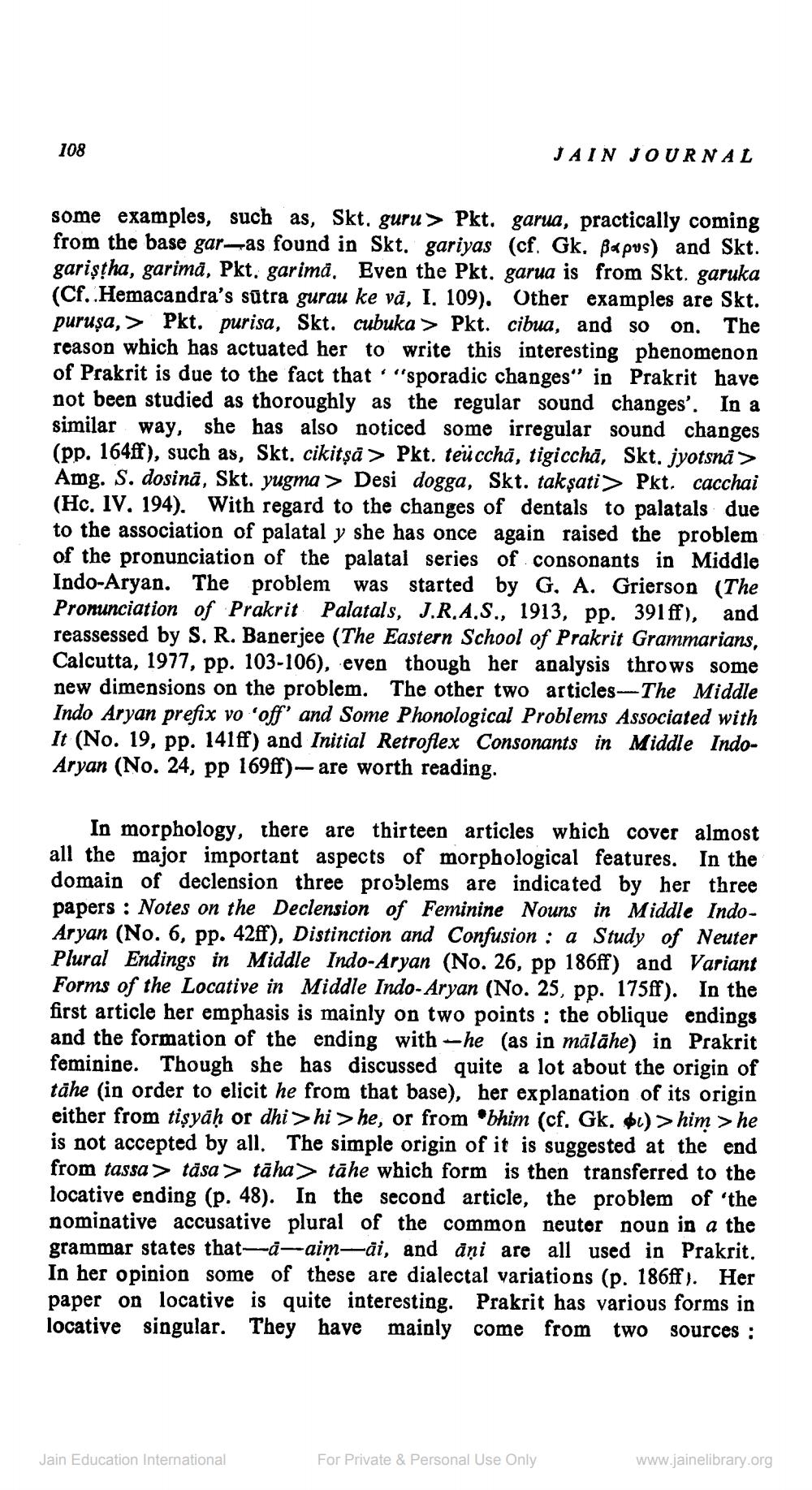________________
108
JAIN JOURNAL
some examples, such as, Skt. guru> Pkt. garua, practically coming from the base gar-as found in Skt. gariyas (cf. Gk. Bapus) and Skt. gariştha, garima, Pkt. garimă. Even the Pkt. garua is from Skt. garuka (Cf. Hemacandra's sūtra gurau ke vă, I, 109). Other examples are Skt. puruşa, > Pkt. purisa, Skt. cubuka > Pkt. cibua, and so on. The reason which has actuated her to write this interesting phenomenon of Prakrit is due to the fact that "sporadic changes in Prakrit have not been studied as thoroughly as the regular sound changes'. In a similar way, she has also noticed some irregular sound changes (pp. 164ff), such as, Skt, cikitsa > Pkt. teücchā, tigicchā, Skt. jyotsna > Amg. S. dosinā, Skt. yugma > Desi dogga, Skt. taksati> Pkt. cacchai (Hc. IV, 194). With regard to the changes of dentals to palatals due to the association of palatal y she has once again raised the problem of the pronunciation of the palatal series of consonants in Middle Indo-Aryan. The problem was started by G, A. Grierson (The Pronunciation of Prakrit Palatals, J.R.A.S., 1913, pp. 391ff), and reassessed by S. R. Banerjee (The Eastern School of Prakrit Grammarians, Calcutta, 1977, pp. 103-106), even though her analysis throws some new dimensions on the problem. The other two articles-The Middle Indo Aryan prefix vo 'off' and Some Phonological Problems Associated with It (No. 19, pp. 141ff) and Initial Retroflex Consonants in Middle IndoAryan (No. 24, pp 169ff)- are worth reading.
In morphology, there are thirteen articles which cover almost all the major important aspects of morphological features. In the domain of declension three problems are indicated by her three papers : Notes on the Declension of Feminine Nouns in Middle IndoAryan (No. 6, pp. 42ff), Distinction and Confusion : a Study of Neuter Plural Endings in Middle Indo-Aryan (No. 26, pp 186ff) and Variant Forms of the Locative in Middle Indo-Aryan (No. 25, pp. 175ff). In the first article her emphasis is mainly on two points : the oblique endings and the formation of the ending with he (as in mālāhe) in Prakrit feminine. Though she has discussed quite a lot about the origin of tähe (in order to elicit he from that base), her explanation of its origin either from tişyaḥ or dhi >hi > he, or from bhim (cf, Gk, 41) > him > he is not accepted by all. The simple origin of it is suggested at the end from tassa> tasa> tāha> tāhe which form is then transferred to the locative ending (p. 48). In the second article, the problem of 'the nominative accusative plural of the common neuter noun in a the grammar states that-a-aimai, and äņi are all used in Prakrit. In her opinion some of these are dialectal variations (p. 186ff). Her paper on locative is quite interesting. Prakrit has various forms in locative singular. They have mainly come from two sources :
Jain Education International
For Private & Personal Use Only
www.jainelibrary.org




